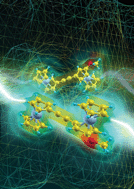The electron spin made its debut in the device world only two decades ago but today our ability of detecting the spin state of a moving electron underpins the entire magnetic data storage industry. This technological revolution has been driven by a constant improvement in our understanding on how spins can be injected, manipulated and detected in the solid state, a field which is collectively named Spintronics. Recently a number of pioneering experiments and theoretical works suggest that organic materials can offer similar and perhaps superior performances in making spin-devices than the more conventional inorganic metals and semiconductors. Furthermore they can pave the way for radically new device concepts. This is Molecular Spintronics, a blossoming research area aimed at exploring how the unique properties of the organic world can marry the requirements of spin-devices. Importantly, after a first phase, where most of the research was focussed on exporting the concepts of inorganic spintronics to organic materials, the field has moved to a more mature age, where the exploitation of the unique properties of molecules has begun to emerge. Molecular spintronics now collects a diverse and interdisciplinary community ranging from device physicists to synthetic chemists to surface scientists. In this critical review, I will survey this fascinating, rapidly evolving, field with a particular eye on new directions and opportunities. The main differences and challenges with respect to standard spintronics will be discussed and so will be the potential cross-fertilization with other fields (177 references).

You have access to this article
 Please wait while we load your content...
Something went wrong. Try again?
Please wait while we load your content...
Something went wrong. Try again?


 Please wait while we load your content...
Please wait while we load your content...